 Alchemy
Alchemy  Mary Magdalene
Mary Magdalene
Mary Magdalene |

|

|
| Written by Editor VOPUS | |
MARY MAGDALENE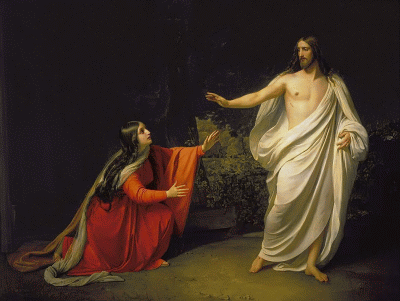
Mary Magdalene is mentioned both in the canonical New Testament, and in various Apocryphal Gospels, as a distinguished disciple of Jesus of Nazareth. She is considered a Saint by the Roman Catholic Church, the Orthodox Church, and the Anglican Communion, who celebrate her feast on July 22. She holds a special importance for the Gnostic schools of Christianity. Her name refers to her place of origin: Mary of Magdala, location situated on the western shore of Lake Tiberias. Mary Magdalene in the New TestamentThe information over Mary Magdalene in the Canonical Gospels is poor. She is cited in relation to four different events:
The aforementioned references are the only paragraphs in the Canonical Gospels in which “Mary of Magdala” is cited. The Western Christian Tradition (Catholic) however, although without relying on written evidence of any kind, has identified Mary Magdalene with other characters cited in the New Testament:

The identity of Mary Magdalene as Mary of Bethany and "the woman who was a sinner", was established in a sermon given by Pope Gregory in 591, in which he said: “She, whom Luke calls the sinful woman, t whom Jose calls Mary -of Bethany, we believe that she is Mary of whom seven devils were expelled according to Mark”.. This is the sermon that has caused along the history the link between Mary Magdalene and these fatal words that have condemned her over many years to be the sinner; today it could be verified that this does not have well-founded bases and the first, the sinner, isn’t necessarily the same as the other two Marys. Spread by the theologians of the third and fourth centuries, this unproven theory was very popular in the nineteenth century, and caused much confusion and a certain discredit to a person that was one of the leading apostles of Christ. Also this fact served in letting her outside the ecclesiastical power, let us remember that the Church always neglected and marginalized women, and even more so when it comes to the hierarchical power which women have never accessed, although we know that among the immediate followers of Jesus there were both male and female, and He made no special distinction between either of them. Mary Magdalene in the Apocryphal Gospels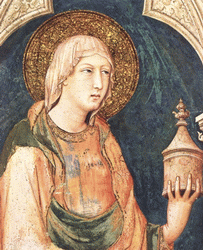
The Gospel of Peter mentions Mary Magdalene only in her role of witness to the resurrection of Jesus: On Sunday morning, Mary Magdalene, disciple of the Lord, -frightened because of the Jews, for they were mad with rage, had not done in the tomb of the Lord what women used to do for their dead ones-, took her friends and came to the tomb where He had been placed. In at least two of the Coptic Gnostic texts found at Nag Hammadi, the Gospel of Thomas and the Gospel of Philip, Mary Magdalene is mentioned as a close disciple of Jesus in a relationship as close as that of the Apostles. In the Gospel of Thomas there are two mentions of Mariham (lodge 21 and 114), which, according to scholars, refer to Mary Magdalene. The second occurrence is part of an enigmatic passage that has been subject to very different interpretations: Simon Peter said: ”Mariham away from us!, as women are not worthy of life”. Jesus replied: “Look, I'll take care of making her male, so that she too will become a living spirit, identical to you men: for every woman who becomes male shall enter the kingdom of heaven”. This text, in the light of contemporary gnosis is very illustrative, even though throughout history has been read with the dead letter. In the Gospel of Philip (log. 32) she is considered the companion (şżą˝É˝żÂ) of Jesus: (There were) three (who) always walked with the Lord: Mary, his mother, and her sister, and Magdalene, the one who was called his companion[şżą˝É˝żÂ]. His sister and his mother and his companion were each a Mary. This remains also clear in another no less significant text which is the Pistis Sophia, which reflects the importance of Mary Magdalene within the group of the Apostles. Pistis Sophia is attributed to Valentine, a prominent and courageous seeker of Truth who had the courage to rebel against papal dogmas of the Catholic Church, who began at that time (first and second centuries AD) to build their ecclesiastical orthodoxy in order to leave out the authentic early Christians who embraced the Gnosis that had been given them by Jesus. Many theologians have no hesitation in stating that “During the second half of the second century and the beginning of the third, the doctrine of Valentine was to be the most powerful and serious of the dissenters from the Church, surpassing the volume of literature of the Church itself”. Finally, another important reference to the character is found in the Gospel of Mary Magdalene, text of which only two third-century Greek fragments are preserved and a more extensive one, in Coptic, of the fifth century. In the text, three Apostles are discussing about the testimony of Mary Magdalene on Jesus. Andrew and Peter distrust her testimony, and it is Levi (the Apostle Matthew) who defends Mary. Mary Magdalene flees the Holy LandThere is a tradition according to which Mary Magdalene (identified here as Mary of Bethany), her brother Lazarus and Maximin, one of the seventy-two disciples, together with some companions, traveled by boat on the Mediterranean Sea fleeing persecution in the Holy Land and finally landed at a place called Saintes-Maries-de-la-Mer near Arles. Later on, Mary Magdalene traveled to Marseilles, from where she undertook the evangelization of Provence, to retire afterwards to a cave - La Sainte Baume - near Marseilles, where she led a life of penance for 30 years. According to this tradition, when the hour of her death arrived she was carried by Angels to Aix-en-Provence, to the oratory of St. Maximinus, where she received the allowance. Her body was buried in a chapel built by Maximinus at Villa Lata, since then known as St. Maximin. Veneration of Mary Magdalene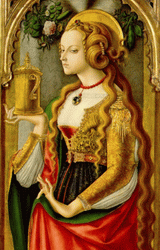
The first place in France where it is known to have existed a cult for Mary Magdalene is the town of Vezelay, in Burgundy. Testimonials of the pilgrimage to the tomb of Mary Magdalene in Vezelay date since at least 1030. On April 27, 1050, a bull from Pope Leo IX officially placed Vézelay abbey under the patronage of Mary Magdalene. Santiago de Voragine relates the official version of the transfer of Saint’s relics from her tomb in the chapel of St. Maximin at Aix-en-Provence to the newly founded abbey of Vézelay, in 771. The Saint Maximin of this legend is a character that combines features of the historical Bishop Maximinus with the Maximinus that, according to legend, accompanied Mary Magdalene, Martha and Lazarus to Provence. Saint-Maximin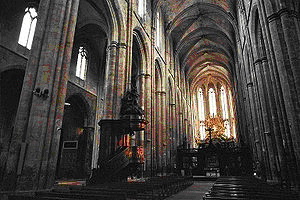
A later cult that attracted many pilgrims began when the body of Mary Magdalene was officially discovered on September 9, 1279, in Saint-Maximin-la-Sainte-Baume, Provence, by the then Prince of Salerno, future King Carlos II of Naples. In that location there is a great Dominican monastery built in Gothic style, one of the most important in the south of France. In 1600, the supposed relics were deposited in a sarcophagus ordered by Pope Clement VIII, but the head was placed separately in a reliquary. The relics were desecrated during the French Revolution. In 1814 the temple was restored and the head of the Saint, that is now worshiped there, was recovered. Important details of Mary Magdalene: Jesus' wife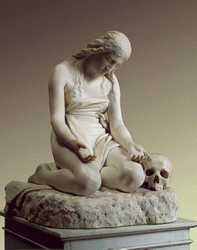
According to Gnostic and esoteric tradition, Mary Magdalene would have been the wife, the consort of Jesus of Nazareth, as well as the repository of a feminist Christian tradition that would have been carefully concealed by the Catholic Church. Later, these ideas have been exploited by several authors of fiction as Peter Berling (Children of the Grail) and Dan Brown (The Da Vinci Code, 2003) among many others, indicating the Merovingian dynasty as the hypothetical dynasty. This idea is supported by several arguments:
Simon Peter said: ”Mariham away from us!, as women are not worthy of life”. Jesus replied: “Look, I'll take care of making her male, so that she too will become a living spirit, identical to you men: for every woman who becomes male shall enter the kingdom of heaven”. Gospel of Mary Magdalene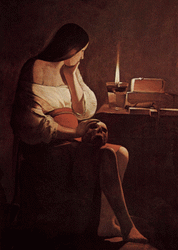
It's called Gospel of Mary Magdalene an Apocryphal Gnostic Gospel, perhaps of the second century, of which have come down to us only fragments. Characteristics of the textOnly three fragments of this gospel are kept: two, very short, in Greek, third-century manuscripts (463 Rylands Papyrus and 3525 Oxyrhynchus Papyrus), and another, a larger one, in Coptic (8052.1 Berolinensis Gnosticus), probably a translation of the original Greek. The Coptic text was found in 1896 by C. Schmidt, though not published until 1955. The Greek fragments were published respectively in 1938 and 1983. None of the fragments mention any author of this gospel. The name traditionally given, Gospel of Mary Magdalene, is due to the citation within the text of a Jesus’ disciple named Mary, who most scholars identify with the Mary Magdalene that appears in the Canonical Gospels. They cannot be subsequent to the third century, as the Greek manuscripts belong to this period. For internal features of the text, like the presence of Gnostic ideas, is usually considered to have been drafted in the second century. ContensFrom the Coptic fragment, which is the most extensive, several pages are missing (namely 1-6 and 11-14). It is a dialogue between Jesus (referred to as "the Savior") and his disciples. After the departure of Jesus, the Apostles are confused: They, however, were saddened and wept bitterly, saying: How to go to the people and preach the gospel of Son of man’s kingdom? If they had with him no consideration, how could they have with us? Then Mary relates a vision and the dialogue she had with Jesus in this vision, which is full of terms belonging to the Gnostic thought. The testimony of Mary is rejected by Andrew and Peter, who doubt that Jesus has chosen a woman over them to reveal secrets to. However, Levi (the apostle Matthew) decides to preach "the Gospel of Mary." According to interpretations such as the one of Karen King, the text reveals the tensions within the early Christian communities among proto-orthodox, represented by Peter, and the Gnostics, symbolized by Mary Magdalene. A similar confrontation exists in other Gnostic texts like the Gospel of Thomas, Pistis Sophia or the Coptic Gospel of the Egyptians. Moreover, according to this text, Mary Magdalene would have been the depository of secret revelations of Jesus, and would have had an outstanding role in the post-Easter Christian community. Certain similarities can be found between the ideas in this Gospel and Eastern religions such as Taoism and Buddhism. Mary Magdalene according to the Catholic ChurchMary Magdalene is venerated by the Catholic Church officially as Saint Mary Magdalene. There are many temples throughout the world dedicated to this Catholic Saint. 
Penitent MagdaleneWhile Eastern Christianity particularly honors Mary Magdalene because of her closeness to Jesus, considering her "equal to the Apostles," in the West, based on the identification with other women from the Gospels (see above), was developed the idea that before knowing Jesus she was engaged in prostitution. This idea generates, firstly, the identification of Mary with the sinner (Lk 7:36-50), of whom it’s said only to have been sinful, and to have loved much; secondly, the reference in Luke 8 : 2, where it is said, this time clearly referring to Mary Magdalene, that of her "had come out seven demons". As it can be seen, nothing in the Gospel passages suggests that Mary Magdalene was devoted to prostitution. No one knows exactly when began the identification of Mary Magdalene with Mary of Bethany and the woman from Luke 7:36-50, but in a homily of Pope Gregory the Great (dead in 591) is unequivocally expressed the identity of these three women, and Mary Magdalene is presented as a repentant prostitute. So the later legend shows her spending the rest of her life in a cave in the desert, doing penance and mortifying her flesh, and Western art representations of “Penitent Magdalene” are very common. The image of Mary Magdalene as a penitent may also be mistakenly linked by tradition to Mary of Egypt, Saint of fifth century, who, according to James of Voragine’s “The Lives of Saints”, had been engaged in prostitution and then moved away into the wilderness to atone for her sins. It is common to see representations of Mary of Egypt, with long hair covering her body wrapped in reed, symbols of her penitence in the desert. These attributes occasionally accompany Magdalene, sometimes creating confusion between the two Saints. In the Catholic tradition, therefore, Mary Magdalene came to be a secondary character, despite her undoubted importance in the evangelical tradition. The relegation suffered by Mary Magdalene has been linked by some authors with the subordinate position of women in the Church. In 1969, the Catholic Church removed from the liturgical calendar the appellative of "penitent" traditionally given to Mary Magdalene; likewise, from that date the lecture from the Gospel of Luke (Lk 7: 36-50) about the sinful woman ceased to be used in the liturgy of the Feast of Mary Magdalene. Since then, the Catholic Church has no longer considered Mary Magdalene a repentant prostitute. However, this remains the prevailing view for many Catholics. Mary Magdalene and other Catholic Saints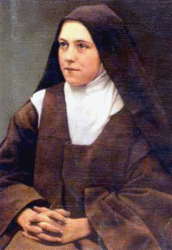
Mary Magdalene was a source of inspiration for one of the most important mystics in the Catholic Church, Theresa of Lisieux, who admired this love so deep, related in the Gospel in which Mary Magdalene thinks to serve whom she loves; this way Theresa decided to devote her life to whom she loved most: Jesus of Nazareth (cf. TL 169 Saint Theresa). In 1894 she wrote, "Jesus has stood up for us in the person of Mary Magdalene". Another prominent Catholic mystic who found inspiration and comfort in Mary Magdalene was the Curch’s doctora Theresa of Avila, who reported having received spiritual help from Mary Magdalene. 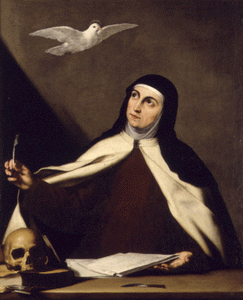
Sources: Wikipedia and Vopus editor Comments (0)
 Write comment
|
| < The Cult of Fire | Alchemy in the sufy literature > |
|---|
| Science |
| Art |
| Philosophy |
| Mysticism/Religion |
| Barbelo: Gnosis Magazine |